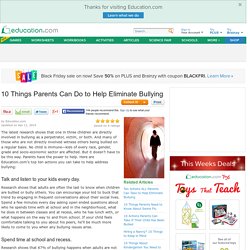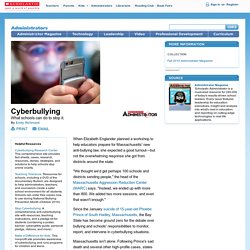

Teen Essay About bullying, school and self-esteem. Bullying.

A word almost every kid dreads. They dread being the outcast. The reject. The person everyone bullies. We Stop Hate . org. Scholastic News: Are You Being Bullied? Cyberbullying By Genet Berhane In an instant-messaging conversation, you might respond with "lol" (laugh out loud) or "brb" (be right back) . . . but what about SOS, a cry for help?

Bullying is not a new problem, but what about when bullies use the Internet as a tool to hurt someone? It's called cyberbullying. You don't have to be physically pushed around to be a victim of bullying—you could be sitting safely in front of your computer at home. Cyberbullying is just as painful as any other bullying. The Star Wars Kid Last year, a teenage boy in Canada became a victim of cyberbullying in front of an audience of millions. Some classmates got their hands on the video and posted it on an online file-sharing system, where people swap information, music, and videos. The boy was so bothered by the situation that he has been under the care of psychiatrists.
How to Respond Officer Dave Cavedon knows a thing or two about making a difference in his community. 10 Things Parents Can Do to Help Eliminate Bullying. The latest research shows that one in three children are directly involved in bullying as a perpetrator, victim, or both.

And many of those who are not directly involved witness others being bullied on a regular basis. No child is immune—kids of every race, gender, grade and socio-economic sector are affected. But it doesn’t have to be this way. Parents have the power to help. Here are Education.com’s top ten actions you can take to help address bullying: Talk and listen to your kids every day. Research shows that adults are often the last to know when children are bullied or bully others. The 3-Minute Interview: Lee Hirsch, anti-bullying activist. Hirsch created of the film "Bully" and The Bully Project, a social action campaign aimed at ending bullying in schools across America.

He will speak Wednesday at the National Press Club in downtown D.C. Why did you create this project? I was bullied as a kid. And I became a filmmaker. Making the film "Bully" was something I had looked at many times. What is the project about? It's is very much like an experiment. How do you create that kind of leverage? It's interesting because what we are celebrating in part on Capitol Hill on Wednesday is that we met and surpassed our goal of getting a million kids to see the film.
Beyond the film, how does the project work? We have created a set of tools that go with it -- lessons that are created for the student that sees the film. What do you believe is behind the uptick in bullying? It has a lot to do with the broader question of school climate and school culture... Bully Official Trailer #1 - Weinstein Company Movie (2012) HD. Cyberbullying: What Teachers and Schools Can Do. The Numbers 42% of kids have been bullied online — 1 in 4 have had it happen more than once. 21% of kids have received mean or threatening e-mail or other messages. 58% have not told their parents about an online bullying incident. 14% have received mean or hurtful comments online. 13% have been the subject of rumors online. 7% have had someone impersonate them online. 8% report receiving a threatening cell phone text. 5% have had a mean or hurtful picture posted.

They may not call it cyberbullying. Students may say they got "dissed" on Facebook or that someone flooded their phone with mean texts. Even little kids have been known to hack into Club Penguin to sabotage each other's games. While most of these incidents occur at home, the problems spill over to the classroom, making cyberbullying an issue teachers can't ignore. The answer isn't forbidding technology, say experts, so much as teaching kids right from wrong. Cyberbullying. When Elizabeth Englander planned a workshop to help educators prepare for Massachusetts' new anti-bullying law, she expected a good turnout—but not the overwhelming response she got from districts around the state.

"We thought we'd get perhaps 100 schools and districts sending people," the head of the Massachusetts Aggression Reduction Center (MARC) says. "Instead, we ended up with more than 800. We added two more sessions, and even that wasn't enough. " Since the January suicide of 15-year-old Phoebe Prince of South Hadley, Massachusetts, the Bay State has become ground zero for the debate over bullying and schools' responsibilities to monitor, report, and intervene in cyberbullying situations. Massachusetts isn't alone. Current data are still being gathered, but 2007 statistics by the National Crime Prevention Council showed that 43 percent of surveyed middle and high school students said they had experienced some form of cyberbullying in the prior 12 months.